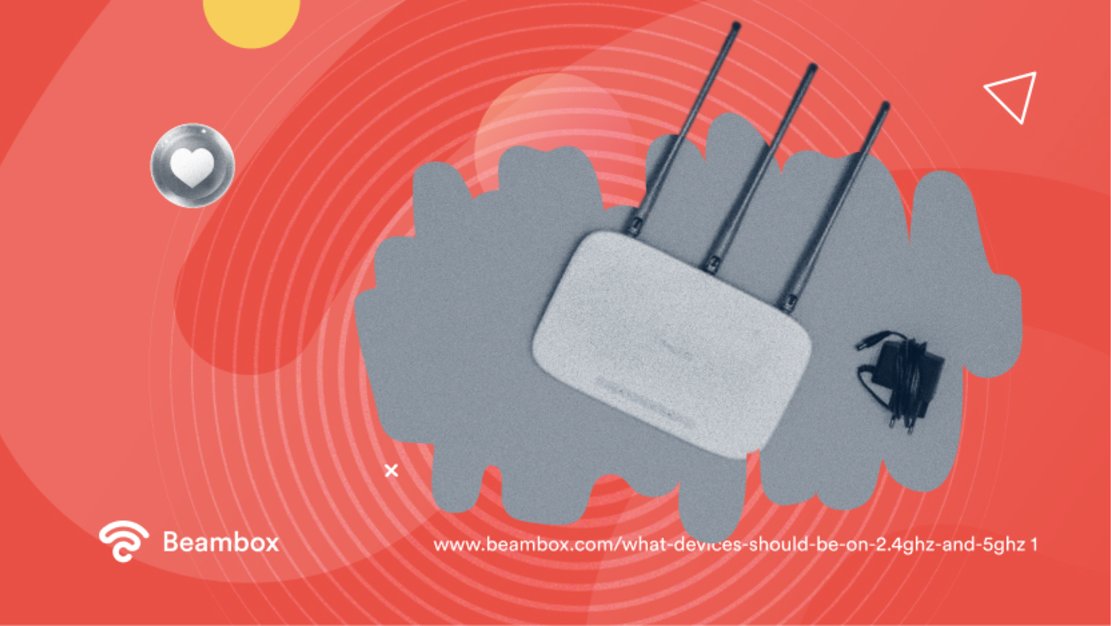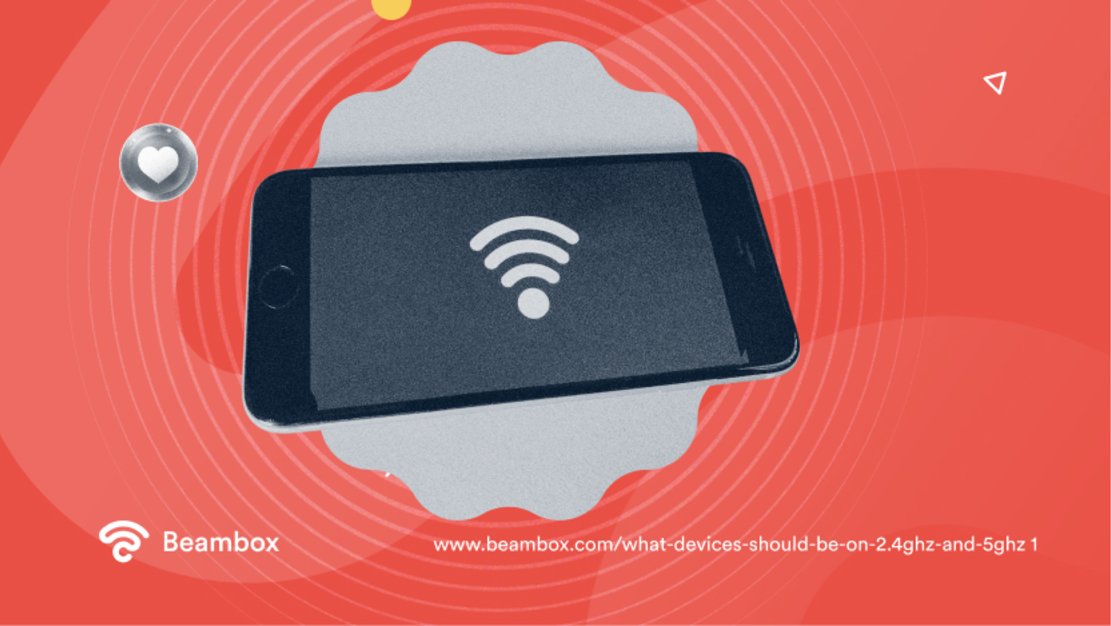If you want to set up your WiFi software, you need to know what devices should be on 2.4GHZ and 5GHZ. Many users, from the top of their heads, assume that 2.4 GHz Wi-Fi and 5 GHz Wi-Fi are internet speed options. They believe that opting for the latter signifies a better and faster speed. While this is true, there are other factors to consider as well, such as:
- The WiFi coverage
- Types of radio signals supported by the router
- Interference from other sources
WiFi capabilities have improved considerably, and the introduction of new protocols has increased the bandwidth of WiFi devices. However, before making any decision on purchasing a router, it’s better to know about the distinction between the two frequencies. Furthermore, you should learn about WiFi bands, long-range coverage, and network performance.
Why is being aware of all of this necessary? The devices operating at these GHz will have an impact on WiFi performance. For example, numerous devices operating on the same frequency can cause interference and slow down your network. Without any knowledge of how these routers operate, you would be venting about the poor internet connection. Therefore, understanding the differences between these separate bands can help you choose the right router for your needs.
Educating yourself on what devices should be on 2.4GHZ and 5GHZ can ultimately lead to a better WiFi experience. This is not only for personal use; the benefits of having the right WiFi can positively impact your business.
What Does GHz Mean?
GHz is short for gigahertz and refers to the 2.4 and 5 GHz frequency at which the wireless network operates. The way WiFi works is by emitting radio signals. The higher the GHz, the faster your network can transfer data. It’s important to note that a higher GHz doesn’t guarantee better internet performance. Other factors, such as interference and distance, can also affect your network speed.
Now that you know what GHz means, it is time to learn what devices should be on 2.4GHZ and 5GHZ.
4 Factors That Differentiate What Devices Should Be On 2.4 GHz and 5 GHz
The average user does not care what these two frequencies mean. All they want is a high-speed WiFi device with a reliable connection. However, if you want to know what devices should be on 2.4GHz and 5GHz, it’s important to understand how these frequencies differ.
This guide provides a thorough explanation.

What Devices Should Be On 2.4 GHz and 5 GHz Factor #1: WiFi Coverage
The 2.4 GHz WiFi frequency has a longer range but a lower bandwidth. This means it has a long-range coverage area, but it comes at a cost, which is slow speed. However, this does not imply that the frequency’s slow speed renders it useless. You can watch videos, browse websites, and use the internet as you would. The quality of the videos would be standard, but this frequency will get the job done.
If you want to play online gaming or attend video conferencing, it is best to switch to 5 GHz. But remember, the device and router should be close to each other because the routing device has a shorter range.

What Devices Should Be On 2.4 GHz and 5 GHz Factor #2: Faster Speed
The 5GHz WiFi frequency has a shorter range but a higher bandwidth, providing faster speeds over a smaller area. It is ideal for streaming high-definition videos or playing online games without lag. However, if you are far from the router, the internet signal will be weak. Therefore, it is wise to shift to the 2.4GHz frequency because the radio signals have a longer range. You can play games or watch videos, but expect interference to occur if plenty of devices connect to the 2.4 GHz WiFi frequency.
Without a doubt, 5 GHz WiFi is faster than 2.4 GHz WiFi. This is because it has a wider channel bandwidth and can transmit more data at once, resulting in faster speeds.
2.4 offers speeds between 450 Mbps and 600 Mbps, while 1300 Mbps is the speed provided by 5 GHz.
With this, you can decide what devices should be on 2.4GHZ and 5GHZ.
Regarding the speed of both GHz, be aware that these are estimates. It is not a promise that you will get the said amount of speed. The actual speed of the internet will depend upon certain factors, such as:
- Your ISP package
- Your bandwidth package
- The number of devices connected
- Potential interference from other WiFi radio signals
What Devices Should Be On 2.4 GHz and 5 GHz Factor #3: Interference
The reason 2.4 GHz is slow is because it runs into a lot of interference. Many other appliances, such as cordless phones and microwaves, use this frequency. Since these electronics interact with radio signals, they can interfere with them and slow down your internet speed.
To avoid this connection disruption, consider upgrading to a 5 GHz frequency for better internet performance. Many electronic components do not use this frequency because it is a new feature not linked to household appliances. This makes it an excellent choice if your needs require better transmission and higher data rates.
What Devices Should Be On 2.4 GHz and 5 GHz Factor #4: Compatibility
Compatibility is an important factor that determines what devices should be on 2.4GHZ and 5GHZ. Almost all devices, including common house electronics, support 2.4 GHz.
Compatibility with 5 GHz may be an issue if you have older devices. So it’s important to check if your devices support 5 GHz before upgrading. However, all the latest technology supports dual-band WiFi.

What Devices Should Be On 2.4 GHz and 5GHz?
There is no hard-and-fast rule regarding the types of devices that must link to a particular WiFi band. The following is a list of the devices and the recommended GHz bands to connect with.
The following devices are ideal for connection to the 2.4 GHz band:
- older smartphones, tablets, and laptops that do not support 5 GHz
- home devices such as security cameras
- devices that require a longer range but don’t need faster speeds, for example, wireless printers
- devices that require long-range coverage
- gaming consoles that don’t require a high-speed connection to play games
The following devices are ideal for connection to the 5 GHz band:
- newer smartphones, tablets, and laptops that support 5 GHz
- devices that require faster speeds, such as streaming devices and high-end gaming consoles.
- smart TVs
- streaming sticks that require a strong and stable connection for high-quality video streaming.
Now that you know what devices should be on 2.4GHz and 5GHz, you must ensure they can support a certain band. To check what WiFi frequency your device supports, you can go to the settings and look for the options. If 5 GHz isn’t on the list, your device does not support it.

Different Types of WiFi Routers
There are various types of WiFi routers available on the market. Each of these routing devices has a different GHz frequency, making them suitable for various requirements. You can determine what devices should be on 2.4GHz and 5GHz by getting to know the different types of WiFi routers. A few of the most common network routers are:
Single-band Routers
A single-band router operates on the 2.4 GHz frequency, suitable for basic internet activities such as browsing and emailing. This device has wide WiFi coverage but works poorly in crowded areas. This is due to the interference of other network devices. Moreover, single-band routers are unsuitable for high-bandwidth activities such as streaming or gaming. If you only need to connect a few devices and don’t require high-speed internet, a single-band router may be sufficient.
Dual-band Routers
As the name suggests, the dual-band router operates on both frequencies. You don’t need to figure out what devices should be on 2.4GHz and 5GHz. It allows for better performance and less interference in crowded areas compared to single-band routers. Dual-band routers also offer the flexibility to connect multiple devices simultaneously without compromising speed or performance. This makes it an excellent choice for households with multiple devices and high bandwidth needs.
Mesh Routers
Mesh routers are new routing devices that use multiple nodes to create a network for long-range coverage. They are ideal for large homes or buildings where a single router may not be adequate. Mesh routers also offer seamless roaming, meaning devices can move from one node to another without losing connection. It works on 2.4 and 5 GHz and automatically picks the former if the device is far away. Mesh routers from various brands, varying in their capabilities and features are widely available in the market.
Tri-band Routers
A tri-band router operates on three frequencies, providing even better performance for high-demand activities such as streaming and gaming. These three frequencies consist of one 2.4 GHz band and two 5 GHz bands. Tri-band routers are the best of both worlds. It is the number one choice for gamers and organizations that need a high-speed connection. Since this device offers both frequencies, it provides coverage and bandwidth. With tri-band routers, you don’t need to worry about what devices should be on 2.4GHZ and 5GHZ.

Should I Connect to 2.4 or 5?
“Should I connect to 2.4 or 5 GHz?” is frequently asked by many users. They inquire about it when they discover that one WiFi band offers long-range coverage while the other promises faster speed. Although each band has its own set of benefits, picking the right one is essential.
When deciding what devices should be on 2.4 GHz and 5GHz, here are a few things you should take into account:
What Devices Should Be On 2.4 GHz and 5 GHz: Area Size
Take into account the area size first. The dimensions of your living space can impact which band is best for you. The 2.4 GHz band may be more suitable if you have a larger home, as it can cover a wider area and pass through solid objects.
However, the 5 GHz band may be more appropriate for compact living conditions. It offers faster speed over shorter distances. It will also not interfere with the devices in your neighbor’s apartment.
What Devices Should Be On 2.4 GHz and 5 GHz: Number of Devices Connected
The number of devices connected to your WiFi network can also affect which band is best for you. If you have multiple devices connected simultaneously, 2.4 GHz may not work. If more devices need a stronger internet connection, the 5 GHz WiFi is better. If 5 GHz isn’t available, you must decide what devices should be on 2.4GHZ and 5GHZ.
What Devices Should Be On 2.4 GHz and 5 GHz: Purpose of Use
When deciding between the 2.4 GHz and 5 GHz bands, it’s crucial to keep the intended usage in mind. If you use WiFi for browsing, checking emails, or other basic tasks, then 2.4 GHz may suffice.
On the other hand, if you stream high-definition videos or play online games, 2.4 will not work here. 5 GHz may be required for a more fluid experience.
What Devices Should Be On 2.4 GHz and 5 GHz: Distance between the device and the router
If the device and router are far apart and you can’t position them close to one another, connect to 2.4 GHz. It provides long-range coverage, and the radio signals can pass through barriers.
How To Change the Frequency Settings?
To change the frequency, you need to access your router’s settings using a web browser. The manual that comes with the router will have the URL address or the IP address. Open that in the web browser and navigate to the wireless settings section or the general settings. The frequency configurations may be different for various routers.
Once you have located the settings, select the frequency band you want to use and save the changes. It’s important to note that not all routers support both 2.4 GHz and 5 GHz frequencies, so check your router’s specifications before making any changes. However, newer routers have both 2.4 and 5 GHz.
Key Takeaway: What Devices Should Be On 2.4GHZ and 5 GHz?
It is not hard to decide which frequency a device should connect to. When it comes to devices that need a stable and fast connection, connect to 5 GHz.
The majority of users would opt for 5 GHz. This is because a fast internet connection is now a demand in today’s online world. Speed is not only limited to online gaming, video conferencing, movies, etc. Live streaming on social media demands a fast and stable internet connection. Furthermore, with the increasing number of smart devices, a 5 GHz network can handle multiple devices simultaneously without compromising speed. This makes it an ideal choice for modern homes and businesses that require high-speed internet for various activities.
On the other hand, devices used for simple browsing can connect to the 2.4 GHz band without any issues.
Choosing the right router with the correct frequency will guarantee a fast and reliable internet connection. If you are offering guest WiFi to keep your customers entertained, Beambox is the best guest WiFi solution. Beambox offers easy setup and customization options to enhance the guest experience and keep your customers happy. Learn about what Beambox has to offer.
Get Started With Free WiFi Marketing
Beambox helps businesses like yours grow with data capture, marketing automation and reputation management.
Sign up for 30 days free